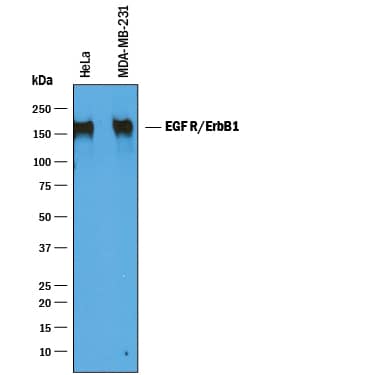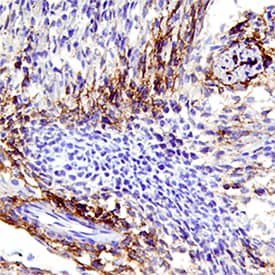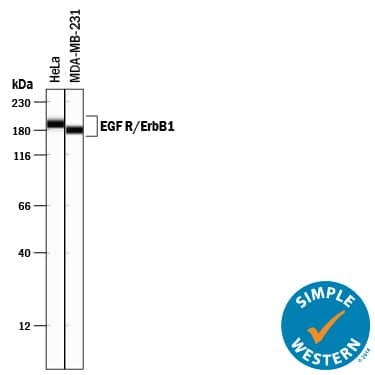Mouse EGFR Antibody
R&D Systems, part of Bio-Techne | Catalog # AF1280


Key Product Details
Species Reactivity
Validated:
Cited:
Applications
Validated:
Cited:
Label
Antibody Source
Product Specifications
Immunogen
Leu25-Ser647
Accession # Q9EP98
Specificity
Clonality
Host
Isotype
Scientific Data Images for Mouse EGFR Antibody
Detection of Human EGFR by Western Blot.
Western blot shows lysates of HeLa human cervical epithelial carcinoma cell line and MDA-MB-231 human breast cancer cell line. PVDF membrane was probed with 0.25 µg/mL of Goat Anti-Mouse EGFR Antigen Affinity-purified Polyclonal Antibody (Catalog # AF1280) followed by HRP-conjugated Anti-Goat IgG Secondary Antibody (Catalog # HAF019). A specific band was detected for EGFR at approximately 170 kDa (as indicated). This experiment was conducted under reducing conditions and using Immunoblot Buffer Group 1.EGFR in Mouse Embryo.
EGFR was detected in immersion fixed frozen sections of mouse embryo (13 d.p.c.) using Goat Anti-Mouse EGFR Antigen Affinity-purified Polyclonal Antibody (Catalog # AF1280) at 15 µg/mL overnight at 4 °C. Tissue was stained using the Anti-Goat HRP-DAB Cell & Tissue Staining Kit (brown; Catalog # CTS008) and counterstained with hematoxylin (blue). Specific staining was localized to developing muscle. View our protocol for Chromogenic IHC Staining of Frozen Tissue Sections.Detection of Human EGFR by Simple WesternTM.
Simple Western lane view shows lysates of HeLa human cervical epithelial carcinoma cell line and MDA-MB-231 human breast cancer cell line, loaded at 0.2 mg/mL. A specific band was detected for EGFR at approximately 180-191 kDa (as indicated) using 2.5 µg/mL of Goat Anti-Mouse EGFR Antigen Affinity-purified Polyclonal Antibody (Catalog # AF1280) followed by 1:50 dilution of HRP-conjugated Anti-Goat IgG Secondary Antibody (Catalog # HAF109). This experiment was conducted under reducing conditions and using the 12-230 kDa separation system.Applications for Mouse EGFR Antibody
Immunohistochemistry
Sample: Immersion fixed frozen sections of mouse embryo (13 d.p.c.)
Simple Western
Sample: HeLa human cervical epithelial carcinoma cell line and MDA‑MB‑231 human breast cancer cell line
Western Blot
Sample: HeLa human cervical epithelial carcinoma cell line and MDA‑MB‑231 human breast cancer cell line
Reviewed Applications
Read 2 reviews rated 5 using AF1280 in the following applications:
Formulation, Preparation, and Storage
Purification
Reconstitution
Formulation
Shipping
Stability & Storage
- 12 months from date of receipt, -20 to -70 °C as supplied.
- 1 month, 2 to 8 °C under sterile conditions after reconstitution.
- 6 months, -20 to -70 °C under sterile conditions after reconstitution.
Background: EGFR
The EGFR subfamily of receptor tyrosine kinases comprises four members: EGFR (also known as Her1, ErbB1, or ErbB), ErbB2 (Neu, Her2), ErbB3 (Her3), and ErbB4 (Her4). All family members are type I transmembrane glycoproteins. They contain an extracellular ligand binding domain containing two cysteine-rich domains and a cytoplasmic domain containing a membrane-proximal tyrosine kinase domain followed by multiple tyrosine autophosphorylation sites (1, 2). The mouse EGFR cDNA encodes a 1210 amino acid (aa) precursor with a 24 aa signal peptide, a 623 aa extracellular domain (ECD), a 23 aa transmembrane segment, and a 540 aa cytoplasmic domain (3). Soluble receptors consisting of the extracellular ligand binding domain are generated by alternate splicing in human and mouse (4-6). Within the ECD, mouse EGFR shares 88% and 93% aa sequence identity with human and rat EGFR, respectively. It shares 44-48% aa sequence identity with the ECD of mouse ErbB2, ErbB3, and ErbB4. EGFR binds a subset of the EGF family ligands, including EGF, amphiregulin, TGF-alpha, betacellulin, epiregulin, HB-EGF, and epigen (1, 2). Ligand binding induces EGFR homodimerization as well as heterodimerization with ErbB2, resulting in kinase activation, heterodimerization tyrosine phosphorylation and cell signaling (7-11). EGFR can also be recruited to form heterodimers with the ligand-activated ErbB3 or ErbB4. EGFR signaling regulates multiple biological functions including cell proliferation, differentiation, motility, and apoptosis (12, 13). EGFR is over-expressed in a wide variety of tumors and is the target of several anti-cancer drugs (14).
References
- Singh, A.B. and R.C. Harris (2005) Cell. Signal. 17:1183.
- Shilo, B.Z. (2005) Development 132:4017.
- Avivi, A. et al. (1991) Oncogene 6:673.
- Reiter, J.L. and N.J. Maihle (1996) Nucleic Acids Res. 24:4050.
- Reiter J.L. et al. (2001) Genomics 71:1.
- Xu, Y.H. et al. (1984) Nature 309:806.
- Graus-Porta, D. et al. (1997) EMBO J. 16:1647.
- Yarden, Y. et al. (1987) Biochemistry 26:1434.
- Burgess, A.W. et al. (2003) Mol. Cell 12:541.
- Lemmon, M.A. et al. (1997) EMBO J. 16:281.
- Cohen, S. et al. (1982) J. Biol. Chem. 257:1523.
- Sibilia, M. and E.F. Wagner (1995) Science 269:234.
- Miettinen, P.J. et al. (1995) Nature 376:337.
- Roskoski Jr., R. (2004) Biochem. Biophys. Res. Commun. 319:1.
Long Name
Alternate Names
Gene Symbol
UniProt
Additional EGFR Products
Product Documents for Mouse EGFR Antibody
Product Specific Notices for Mouse EGFR Antibody
For research use only

